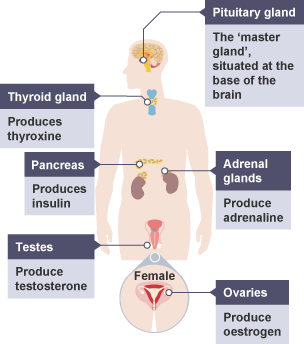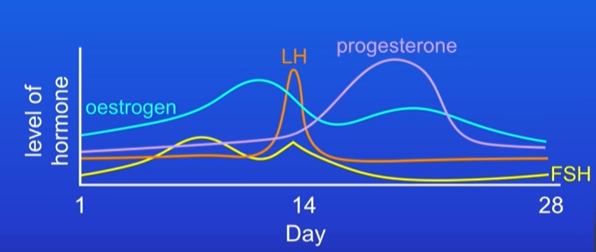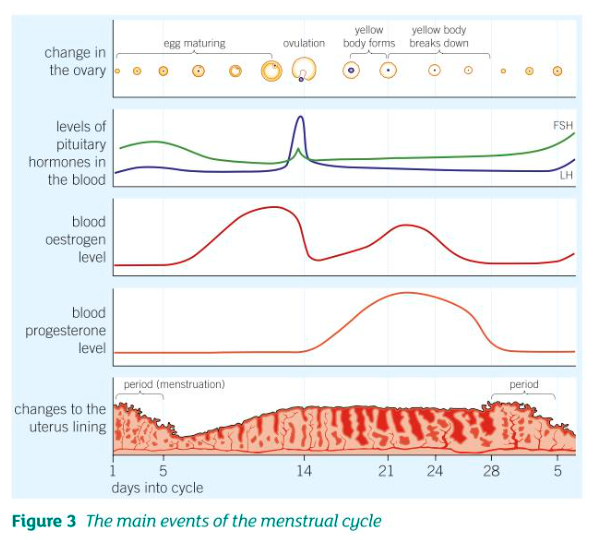biology b11 - hormonal coordination
1/23
There's no tags or description
Looks like no tags are added yet.
Name | Mastery | Learn | Test | Matching | Spaced |
|---|
No study sessions yet.
24 Terms
what is the endocrine system?
the endocrine system is composed of glands, which secrete chemicals (hormones) directly into the bloodstream
the blood carries these hormones to a target organ where it produces an effect
compared to the nervous system, the system’s effects are slower, however they last for longer
function of the pituitary gland + position of glands across body?
the pituitary gland is located in the brain and is the ‘master gland’ of the body; it secretes several hormones into the blood in response to body conditions. these hormones in turn, act on other glands, to stimulate other hormones to be released, and their consequent effects

how does the pancreas control blood glucose levels?
if blood glucose levels are too high, the pancreas produces the hormone insulin, which travels around the body via the bloodstream, stimulating body cells into taking up glucose from the blood
insulin also stimulates liver and muscle cells into storing excess glucose as the storage molecule glycogen
this causes blood glucose to return to the normal level - homeostasis has taken place
if blood glucose levels are too low, the pancreas releases the hormone glucagon into the bloodstream, which stimulates liver cells into converting stored glycogen back into glucose
this glucose is released back into the blood, causing blood glucose to return to the normal level - homeostasis has taken place
because insulin and glucagon have opposite effects on blood glucose concentration, they form a negative feedback cycle
type 1 diabetes - causes & treatment
the pancreas does not produce enough insulin to control blood glucose, so it is characterised by uncontrolled high blood glucose levels
people with type 1 diabetes inject themselves with insulin if their blood glucose rises too much and monitor their blood glucose concentration
there is no cure for the disease
type 2 diabetes - causes & treatment
the body stops responding to insulin produced by the pancreas, so blood glucose levels can rise too high
it is often treated with a diet containing a controlled amount of carbohydrates, to prevent spikes in blood glucose
patients are also advised to exercise regularly as a major risk factor for type 2 diabetes is obesity
what is negative feedback?
negative feedback systems work to maintain a steady state
whatever changes made to the internal environment of the body, negative feedback cycles work to oppose this change and restore optimal conditions
thyroxine and negative feedback?
thyroxine levels are controlled by negative feedback
thyroxine, produced in the thyroid gland, stimulates the BMR - basal metabolic rate, which plays an important role in growth and development
brain monitors level of thyroxine in the blood and when it falls, the pituitary gland releases TSH into the bloodstream, which triggers thyroid gland into releasing more thyroxine into blood
increased thyroxine level detected by the brain, stimulating pituitary gland to stop releasing TSH, and therefore stop the increase in thyroxine
function of adrenaline in the body?
the hormone adrenaline is not involved in a negative feedback loop
the adrenal glands at the top of the kidneys secrete adrenaline, a hormone which is rapidly carried around the body in the blood in times of fear and stress
adrenaline boosts the delivery of oxygen and glucose to the brain and muscles, thus preparing the body for ‘fight or flight’
once the danger is over and raised awareness is no longer needed, the adrenal glands stop releasing adrenaline, and systems return to their resting levels
adrenaline causes the heart rate and breathing rate and mental awareness to increase
functions of the hormones in human reproduction?
during puberty, reproductive hormones cause secondary sex characteristics to develop e.g. pubic hair
testosterone is the main male reproductive hormone, produced in the testes, which stimulates sperm production
oestrogen is the main female reproductive hormone, produced in the ovaries. at puberty, eggs begin to mature and one is released approximately every 28 days (ovulation)
the menstrual cycle - process?
every 28 days ovulation takes place, where the ovaries release an egg
in preparation for the release of the egg, the uterus lining becomes thick and spongy
the egg travels to the uterus, and if sperm is present, the egg can become fertilised - if this happens, it can implant into the uterus wall, and develop into a baby
however, if the egg is not fertilised, both the egg and uterus lining are released - we call this a period
the menstrual cycle - hormones involved?
FSH (follicle stimulating hormone) causes eggs to mature in the ovaries and stimulates oestrogen production in ovaries
LH (luteinising hormone) causes eggs to be released (ovulation)
oestrogen (produced by the ovaries) causes the lining of the uterus to develop, inhibits the release of FSH and stimulates the release of LH
progesterone maintains the lining of the uterus and inhibits the release of FSH and LH

the menstrual cycle - interaction between hormones?
FSH is released by the pituitary gland, and it travels in the blood to the ovaries, where it causes an egg to mature, and triggers the ovaries to make oestrogen
oestrogen causes the uterus lining to thicken and build up while also inhibiting the release of further FSH
the pituitary gland now releases LH, which causes ovulation to take place
after ovulation, the ovaries now produce progesterone, which inhibits the release of both FSH and LH, and maintains the thickness of the uterus incase the mature egg is fertilised and implanted
the level of progesterone will fall if fertilisation does not take place
the uterus lining and egg are now released, and the woman has a period

contraceptive methods - hormonal?
oral contraceptives (birth control); inhibit FSH production, preventing eggs from maturing; highly effective if taken correctly, but must be taken daily; if a woman forgets to take the pill, this reintroduces risk of pregnancy; certain pills have side effects including blood clots and breast cancer, but these risks are small
implant/skin patch/injection; slowly release progesterone, to inhibit the maturation and release of eggs for several months/years; more convenient than taking a daily pill; can have side effects
no hormonal contraceptive methods protect against STI/STDs
contraceptive methods - non-hormonal?
spermicide (chemical method); kills or disables sperm; readily available but not very effective at preventing pregnancy
condom/diaphragm (barrier methods); prevent the sperm from reaching an egg, and fertilising it; no side effects as they don’t use hormones, and can protect against STI/STDs; can break or slip off, so are more effective when used along with spermicides
IUD (intrauterine device) /the coil; prevents the implantation of an embryo/release hormones to reduce chances of pregnancy; highly effective for up to 10 years, and have very few side effects; do not protect against STI/STDs
sterilisation (surgical method); in women, prevents eggs from reaching uterus; in men, prevents sperm from leaving penis; highly effective methods but difficult to reverse, so a person must be sure they don’t want (any more) children before proceeding; does not protect against STI/STDs
abstinence (natural method); not having sexual intercourse during the time after ovulation; very hard to tell when a woman has ovulated, making prediction difficult and method does not protect against STI/STDs
why can the issues surrounding contraception not be answered by science alone?
religious reasons; the catholic church teaches that all contraception is unethical, other than natural methods
personal reasons; many believe it should be down to individual choice to choose which form of contraception is best for them
health reasons; many people recognise that condoms/barrier methods reduce the risk of obtaining STI/STDs
using hormones to treat infertility - fertility drugs?
FSH and LH are given to a woman, causing the woman to ovulate more than usual
the combination of these two hormones is known as the fertility drug
this increases the chances of her getting pregnant through sexual intercourse
using hormones to treat infertility - IVF?
AKA in vitro fertilisation
fertilisation takes place outside the body
women are treated using FSH and LH causing several of her eggs to mature
these eggs are then collected from the mother, and sperm from the father is also collected; the eggs can now be fertilised in the laboratory
fertilised eggs develop into embryos, and once they are tiny balls of cells, they are inserted into the mother’s uterus
the embryos develop inside the mother naturally
advantages and disadvantages of IVF?
fertility treatment gives women the chance to have a baby of their own
but it is very emotionally stressful for both parents, and physically demanding on the mother
success rates are not high
treatment can lead to multiple births, which are risky for both the mother and her babies
many embryos are not implanted in the mother and discarded which some people consider unethical
very expensive treatment, and some believe money could be better spent on treating other conditions such as cancer
plant hormones - role in phototropism?
plant shoots grow towards the light; this is known as phototropism
through their experiments, scientists deduced that shoot tips only produce a plant hormone known as auxin, and that shoot tips are sensitive to light, but lower parts are not
unequal distributions of auxin causes unequal growth rates in plant roots/shoots
auxin triggers cell growth at the very tips of shoots
light causes auxin to concentrate on the darker side of the shoot tip
this causes auxin to spread down the shoot, so cells on the darker side grow faster than the cells in the light
this causes shoots to bend, as they grow towards the light
plant hormones - role in geotropism/gravitropism
plant roots grow towards the force of gravity - this is known as geotropism / gravitropism
auxin is produced in plant roots but gravity causes it to concentrate on the lower side of the root
in roots, auxin INHIBITS cell growth
therefore the lower side of roots grows slower than the upper side
this causes roots to grow towards the force of gravity (downwards)
plant hormones - ethene and gibberellins
gibberellins are important in initiating seed germination
ethene controls cell division and fruit ripening
required practical 8 - plant responses - method?
pour a fixed volume of water into 3 petri dishes and add cotton wool
place 10 seeds in each petri dish
place the petri dishes in a warm area, undisturbed e.g. an incubator
allow time for the seeds to germinate, adding equal volumes more of water if necessary
if not all seeds have germinated into seedlings, remove excess ones, ensuring each dish has the same number of seedlings
place one petri dish in full sunlight, beside a window, one in partial sunlight, and the other in a dark cupboard
use a ruler and or piece of string to measure the seedlings’ height daily, for at least a week
record measurements in a table
find the mean height of the seedlings each day
plot a graph of the mean height of seedlings against the number of days
required practical 8 - plant responses - sources of error & risk assessment?
risk assessment:
seeds may be a biohazard; wash hands thoroughly after handling
sources of error:
sample sizes for each environmental condition may be too small
seedlings in the same petri dish may not receive the same sunlight exposure
temperature could be another factor affecting seedling growth in addition to sunlight exposure
uses of plant hormones?
ethene is used in the food industry to control the ripening of fruit during transport and storage; it converts the starch stored by fruits into sugar; it is naturally produced by bananas
auxins can be used:
as weed killers
as rooting powders
to promote growths in tissue culture
gibberellins can be used to:
end seed dormancy (by forcing seeds to germinate earlier than they normally would)
encourage plants to flower
increase fruit size